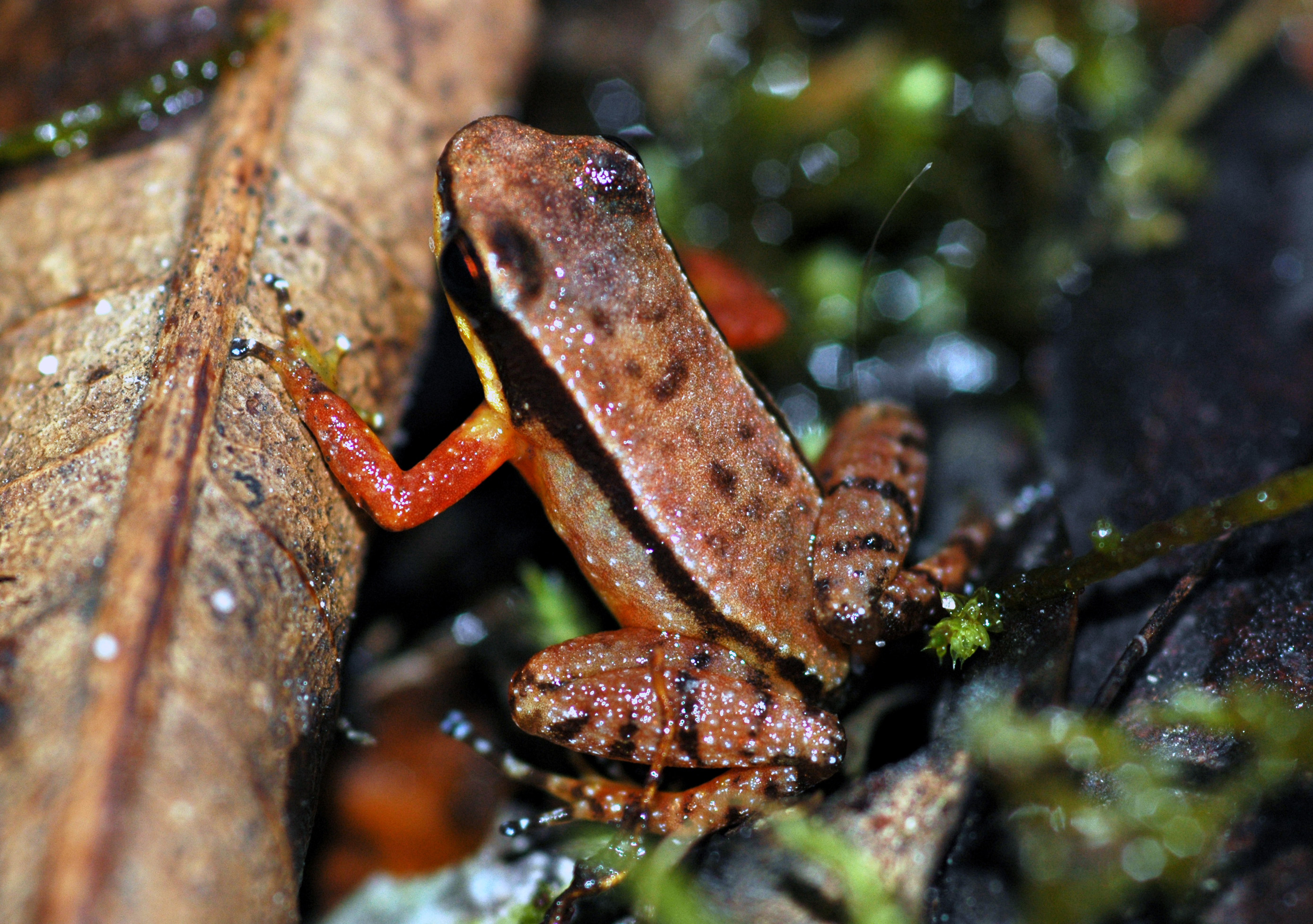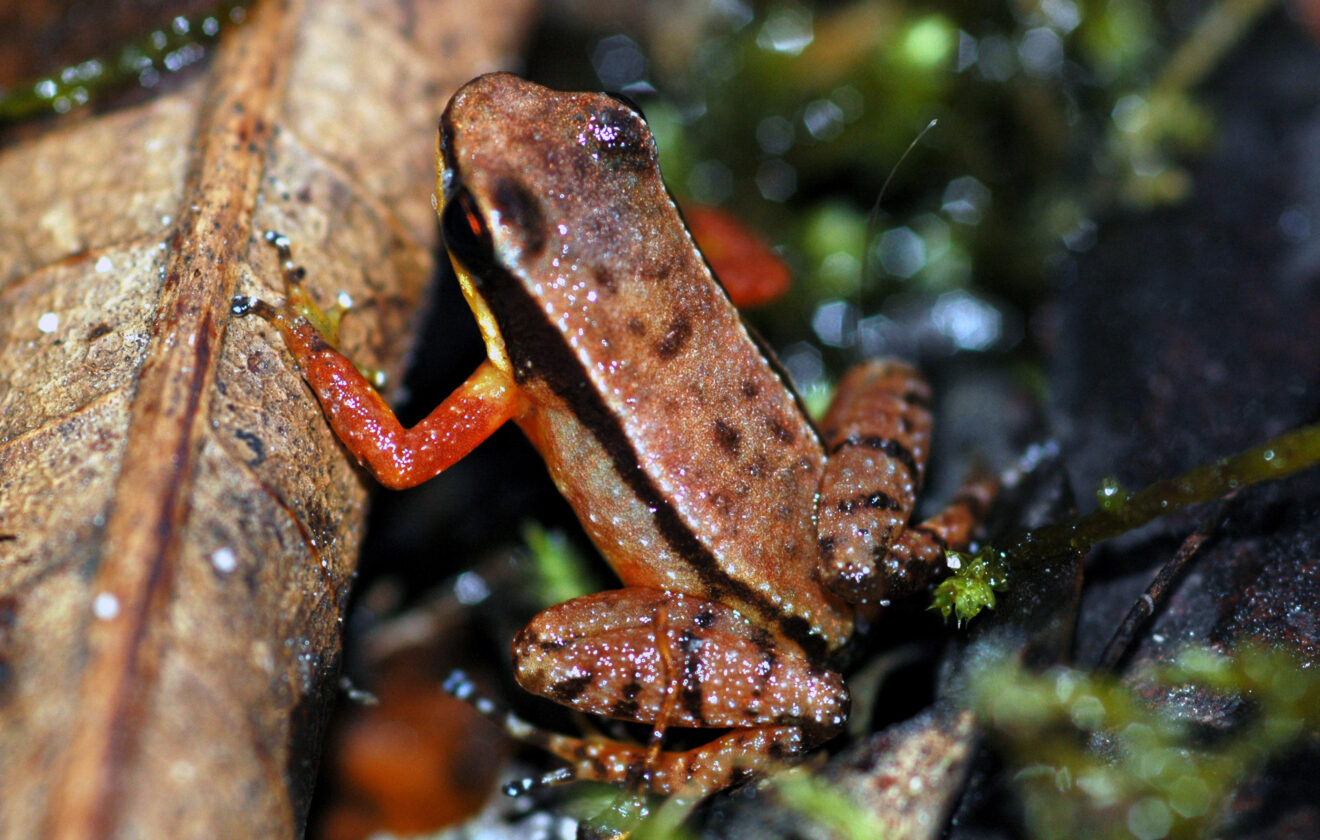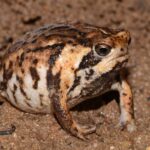Anomaloglossus kaiei: Portrait of a Hidden Jewel of Guyana’s Rainforests#
Hidden beneath the verdant canopy and dense foliage of Guyana’s pristine rainforests lies a tiny, enigmatic amphibian—a jewel-like frog known scientifically as Anomaloglossus kaiei. Often overlooked due to its inconspicuous size and elusive nature, this remarkable species encapsulates the very essence of rainforest biodiversity, serving as both a marvel of ecological adaptation and a subtle guard of forest health. Measuring just a fraction of the size of a typical backyard frog, these miniature inhabitants are captivating both in their delicately patterned appearance and the fascinating stories woven into their lifecycle.
Named after the mystical Mount Kaiei, a remote biodiversity hotspot in Guyana, Anomaloglossus kaiei was first described in recent decades, highlighting both the expansiveness of our planet’s unexplored natural wealth and the urgency of conservation action. In a rapidly changing world where forest ecosystems are constantly at risk, understanding, protecting, and cherishing these small yet significant amphibians becomes a mission of global importance.
Taxonomy and Classification#
Anomaloglossus kaiei belongs to the diverse amphibian family Aromobatidae, a group frequently referred to as “rocket frogs” due to their sudden and acrobatic leaps when disturbed. Within this family, the genus Anomaloglossus comprises numerous brightly colored, terrestrial frogs distributed across South America’s Guiana Shield. This region includes parts of Venezuela, Guyana, Suriname, and French Guiana, renowned for hosting exceptional biological diversity.
Closely related species in this genus often display intricate patterns and subtle coloration adapted to blend into their leafy surroundings. Initially discovered during biological surveys into these less explored habitats, Anomaloglossus kaiei exemplifies the value of continuous scientific exploration and taxonomy. Establishing clear species boundaries helps researchers better understand the evolutionary history, ecological adaptation, and conservation priorities for these uniquely adapted amphibians.
Natural Habitat#
A Jewel of the Guiana Shield#
The homeland of Anomaloglossus kaiei lies mostly within the undisturbed rainforest patches of Guyana’s Kaieteur National Park region, as well as related mountainous and hilly terrains characterized by pristine freshwater streams and lush vegetation. Here, amidst dense ferns, towering bromeliads, moss-laden trees, and rocky crevices, this frog has crafted a niche specialized enough for its survival but invisible to most casual observers.
The Kaieteur Plateau and surrounding mountainous microhabitats provide the ideal combination of moisture, shade, and abundant prey, resulting in micro-environments specifically suited to amphibian diversity. Crystalline water flows through granite cliffs and tumbling waterfalls, pooling into sheltered streams fringed by abundant plant life. These streamsides and wet leaf litter provide essential habitat and serve as reproductive sites for Anomaloglossus kaiei, which has adapted finely to navigate these unique environmental conditions.
In nature, every frog requires a habitat tailored exclusively to its needs, and for Anomaloglossus kaiei, these pristine waters are irreplaceable incubators of life, sheltered from predators and rich in prey organisms.
Physical Characteristics#
Nature’s Subtle Masterpiece#
Small—no larger than the tip of an adult human thumb—and remarkably camouflaged, Anomaloglossus kaiei possesses a delicate yet robust physique adapted impeccably to its humid forest home. The dorsal (upper) surface varies in shades ranging from mottled browns and golds to earthy greens, allowing these frogs to blend seamlessly with leaf litter and tree bark. Such cryptic coloration plays a crucial role in protection from predation by forest-dwelling birds, reptiles, and mammals.
On closer inspection, fine detailing emerges—a subtle striping along the legs, intricate spots, and flecks that mimic decaying foliage and damp earth. Their skin texture, often moist and smooth, permits easy transfer of water and oxygen, essential for maintaining hydration levels in a forest environment where humidity may fluctuate.
One notable evolutionary trait among Aromobatidae family members, including Anomaloglossus kaiei, is their small but muscular hind limbs, enabling impressive leaps to evade predators or pursue agile prey and rapidly navigate their cluttered forest floor habitat.
Behavior and Life Cycle#
Lives Hidden Among Forest Streams#
An active yet elusive species, Anomaloglossus kaiei spends significant amounts of daylight concealed under leaves or among tangled roots and rocks, emerging during cooler times or after rains to forage. Primarily insectivorous, these frogs consume an assortment of ants, beetles, tiny insects, and arthropods—an ecological diet finely attuned to forest floor availability.
Breeding behaviors among members of the genus Anomaloglossus are particularly fascinating. Males establish small territories along shaded rivulets or streamside pools, engaging in vocal performances that sound like soft, repeated chirping notes—a gentle chorus easily overshadowed by the forest’s louder residents. These persistent but subtle calls attract receptive females who selectively choose mates based on call quality and territory location.
Females deposit small clutches of eggs in humid openings beneath plants or near gently flowing streams. Unlike many amphibians, this species engages in direct-developing reproductive strategies where tadpoles hatch as fully formed, miniature froglets, bypassing the typical aquatic tadpole stage. This adaptive trait reduces their susceptibility to predation and dependence on large aquatic bodies, an invaluable adaptation in environments where permanent water is limited.
Ecological Role#
Small but mighty, Anomaloglossus kaiei plays a pivotal ecological role as a predator and prey within its rainforest home. By consuming a variety of small invertebrates, they help maintain ecological balance among forest floor communities, indirectly controlling pest populations that might otherwise damage plant life. Conversely, these frogs form an essential food source for larger amphibians, birds, snakes, and small mammals, thereby representing an important link in complex food webs.
Perhaps more critically, their sensitivity to environmental changes renders them key bio-indicators, serving as vigilant sentinels of ecosystem health. Amphibians’ permeable skins readily absorb chemicals, pollutants, or pathogens, making this species particularly sensitive to ecological disturbances. Monitoring their populations can signal broader environmental shifts and ecosystem threats early enough for meaningful conservation action.
Threats and Conservation Status#
Due primarily to its limited geographic range in a select region of Guyanese forests around Kaieteur National Park, Anomaloglossus kaiei faces heightened vulnerability to habitat loss and climate-induced environmental changes. Fortunately, the remote and relatively inaccessible nature of its main habitats has so far helped shield it from extensive habitat destruction. However, threats such as deforestation, illegal mining, habitat fragmentation, and climate instability may impinge upon future survival.
Although the International Union for Conservation of Nature (IUCN) has yet to formally assess Anomaloglossus kaiei specifically, conservationists advocate for greater research and protective measures given its exceptional endemism and vulnerability. Initiatives aimed at expanding protected areas, conducting ecological research, and promoting conservation education among local communities remain essential steps toward safeguarding its future.
Cultural and Scientific Significance#
Beyond ecological value, species like Anomaloglossus kaiei hold unique scientific and cultural significance. From a scientific perspective, studying its remarkable adaptability could inform conservation strategies for other threatened amphibian species facing comparable environmental challenges. Furthermore, indigenous communities in the Guiana Plateaus recognize these frogs among countless entities within their traditional ecological knowledge systems. Such cultural ties underscore the importance of community-led conservation efforts, intrinsically connecting species survival with traditional practices and values.
Conclusion#
With their gentle chorus hidden beneath the ever-thriving rainforest canopy, Anomaloglossus kaiei embodies both the pristine wonder of Guyana’s natural heritage and the critical urgency of protecting Earth’s fragile biodiversity. By better understanding these minute forest residents, we cultivate respect and stewardship for the lush ecosystems that nurture such treasures. Now, more than ever, recognizing the beautiful interconnectivity of nature through species like Anomaloglossus kaiei inspires us to deepen our commitment to conservation. Every action we take today echoes through the forests of tomorrow—ensuring the enduring presence of these remarkable amphibians for generations to admire and cherish.











